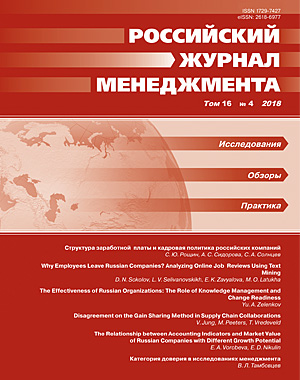Why Employees Leave Russian Companies? Analyzing Online Job Reviews Using Text Mining
DOI:
https://doi.org/10.21638/spbu18.2018.402Аннотация
In this study we analyze topics and sentiments of online job reviews for 989 organizations operating across 12 different knowledge-intensive industries in Russia. Using text mining techniques, such as topic modeling and sentiment analysis, we identify factors of job satisfaction and examine how they differ for former and current employees of Russian organization. The analysis reveals that (1) working arrangements and schedule, (2) working conditions, (3) job content, (4) salary/wage, (5) career development, (6) psychological climate and interpersonal relations with co-workers are the six key topics discussed by employees online in relation to job satisfaction, with the latter — psychological climate and interpersonal relations — being the most widely discussed topic, especially for current employees. Overall, our study suggests that in their decision to leave the company, employees are more likely to tolerate economic factors of job satisfaction (such as salary, career development and working arrangements) rather than socioemotional factors (such as poor relationships with their co-workers and content of work).
Ключевые слова:
employee turnover, job satisfaction, text mining, topic modeling, sentiment analysis, Russia
Скачивания
Библиографические ссылки
REFERENCES
Загрузки
Опубликован
Как цитировать
Выпуск
Раздел
Лицензия
Статьи журнала «Российский журнал менеджмента» находятся в открытом доступе и распространяются в соответствии с условиями Лицензионного Договора с Санкт-Петербургским государственным университетом, который бесплатно предоставляет авторам неограниченное распространение и самостоятельное архивирование.





